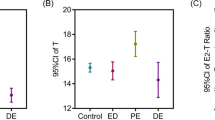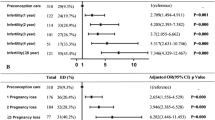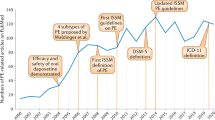Abstract
Although premature ejaculation (PE) is a common male sexual dysfunction, its pathophysiology has not been fully elucidated. Several medical problems such as erectile dysfunction, depression, anxiety, hormonal disorders and chronic prostatitis may play a role in the etiology of acquired PE. This study aims to evaluate the frequency of these etiologic factors among patients with acquired PE. Between May and July 2016, 53 men with acquired PE were included in the study. Self-estimated intravaginal ejaculation latency time (IELT) of these patients was recorded along with their medical history and physical examination findings. Moreover, 5-item version of the International Index of Erectile Function (IIEF-5), premature ejaculation profile (PEP), anxiety and depression scales (STAI-1, STAI-2, and BECK), and chronic prostatitis symptom index (NIH-CPSI) were administered. Fasting plasma glucose, follicle stimulating hormone (FSH), luteinizing hormone (LH), prolactin, total and free testosterone, total prostate specific antigen, thyroid and thyroid stimulating hormone levels were measured. Urine analysis and 2 cup tests were also studied. Mean age of the patients was 42.41 ± 11.14 (22–60). Mean duration of the PE complaint was 34.18 ± 36.76 (3–144) months. Mean IELT time of the patients was 38.28 ± 30.79 (3–180) s. Of the patients; 69.81%, 62.26%, 56.60%, 45.28%, 30.19%, 24.53%, 16.98%, 15.09%, and 7.55% had depression, chronic prostatitis, erectile dysfunction, anxiety, diabetes mellitus, abnormal FSH or LH, hypoprolactinemia, hyperthyroidism, and high testosterone levels, respectively. The results of our study revealed that anxiety disorders, depression, erectile dysfunction, and chronic prostatitis are common among patients with acquired PE and may play role in the etiology of this problem. There is a need for further researches related to the exact pathophysiology of acquired PE with larger number of patients.
This is a preview of subscription content, access via your institution
Access options
Subscribe to this journal
Receive 8 print issues and online access
$259.00 per year
only $32.38 per issue
Buy this article
- Purchase on Springer Link
- Instant access to full article PDF
Prices may be subject to local taxes which are calculated during checkout
Similar content being viewed by others
References
Serefoglu EC, Yaman O, Cayan S, Asci R, Orhan I, Usta MF, et al. Prevalence of the complaint of ejaculating prematurely and the four premature ejaculation syndromes: results from the Turkish Society of Andrology Sexual Health Survey. J Sex Med. 2011;8:540–8.
Lee SW, Lee JH, Sung HH, Park HJ, Park JK, Choi SK, et al. The prevalence of premature ejaculation and its clinical characteristics in Korean men according to different definitions. Int J Impot Res. 2013;25:12–7.
Fugl-Meyer K, Fugl-Meyer AR. Sexual disabilities are not singularities. Int J Impot Res. 2002;14:487–93.
Gao J, Zhang X, Su P, Shi K, Tang D, Hao Z, et al. Prevalence and impact of premature ejaculation in outpatients complaining of ejaculating prematurely: using the instruments of intravaginal ejaculatory latency time and patient-reported outcome measures. Int J Impot Res. 2014;26:94–9.
Saitz TR, Serefoglu EC. The epidemiology of premature ejaculation. Transl Androl Urol. 2016;5:409–15.
Schapiro B. Premature ejaculation, a review of 1130 cases. J Urol. 1943;50:374–9.
Serefoglu EC, McMahon CG, Waldinger MD, Althof SE, Shindel A, Adaikan G, et al. An evidence-based unified definition of lifelong and acquired premature ejaculation: report of the second international society for sexual medicine ad hoc committee for the definition of premature ejaculation. Sex Med. 2014;2:41–59.
Gao J, Zhang X, Su P, Liu J, Xia L, Yang J, et al. Prevalence and factors associated with the complaint of premature ejaculation and the four premature ejaculation syndromes: a large observational study in China. J Sex Med. 2013;10:1874–81.
Waldinger MD, Schweitzer DH. The use of old and recent DSM definitions of premature ejaculation in observational studies: a contribution to the present debate for a new classification of PE in the DSM-V. J Sex Med. 2008;5:1079–87.
Bronner G, Israeli-Korn S, Hassin-Baer S, Yahalom G. Acquired premature ejaculation in Parkinson’s disease and possible mechanisms. Int J Impot Res. 2018;30:153–7.
McMahon CG, Jannini EA, Serefoglu EC, Hellstrom WJ. The pathophysiology of acquired premature ejaculation. Transl Androl Urol. 2016;5:434–49.
Gao J, Xu C, Liang C, Su P, Peng Z, Shi K, et al. Relationships between intravaginal ejaculatory latency time and national institutes of health-chronic prostatitis symptom index in the four types of premature ejaculation syndromes: a large observational study in China. J Sex Med. 2014;11:3093–101.
Chierigo F, Capogrosso P, Boeri L, Ventimiglia E, Frego N, Pozzi E, et al. Lower urinary tract symptoms and depressive symptoms among patients presenting for distressing early ejaculation. Int J Impot Res. 2019. [Epub ahead of print].
Cihan A, Demir O, Demir T, Aslan G, Comlekci A, Esen A. The relationship between premature ejaculation and hyperthyroidism. J Urol. 2009;181:1273–80.
Carani C, Isidori AM, Granata A, Carosa E, Maggi M, Lenzi A, et al. Multicenter study on the prevalence of sexual symptoms in male hypo- and hyperthyroid patients. J Clin Endocrinol Metab. 2005;90:6472–9.
el-Sakka AI. Severity of erectile dysfunction at presentation: effect of premature ejaculation and low desire. Urology. 2008;71:94–8.
Rosen RC, Cappelleri JC, Smith MD, Lipsky J, Pena BM. Development and evaluation of an abridged, 5-item version of the International Index of Erectile Function (IIEF-5) as a diagnostic tool for erectile dysfunction. Int J Impot Res. 1999;11:319–26.
Patrick DL, Giuliano F, Ho KF, Gagnon DD, McNulty P, Rothman M. The premature ejaculation profile: validation of self-reported outcome measures for research and practice. BJU Int. 2009;103:358–64.
Serefoglu EC, Yaman O, Cayan S, Asci R, Orhan I, Usta MF, et al. The comparison of premature ejaculation assessment questionnaires and their sensitivity for the four premature ejaculation syndromes: results from the Turkish society of andrology sexual health survey. J Sex Med. 2011;8:1177–85.
Gaudry E, Vagg P, Spielberger CD. Validation of the state-trait distinction in anxiety research. Multivar Behav Res. 1975;10:331–41.
Beck AT, Epstein N, Brown G, Steer RA. An inventory for measuring clinical anxiety: psychometric properties. J Consult Clin Psychol. 1988;56:893–7.
Litwin MS, McNaughton-Collins M, Fowler FJ Jr., Nickel JC, Calhoun EA, Pontari MA, et al. The National Institutes of Health chronic prostatitis symptom index: development and validation of a new outcome measure. Chronic Prostatitis Collaborative Research Network. J Urol. 1999;162:369–75.
Parnham A, Serefoglu EC. Classification and definition of premature ejaculation. Transl Androl Urol. 2016;5:416–23.
McMahon CG, Althof S, Waldinger MD, Porst H, Dean J, Sharlip I, et al. An evidence-based definition of lifelong premature ejaculation: report of the International Society for Sexual Medicine Ad Hoc Committee for the Definition of Premature Ejaculation. BJU Int. 2008;102:338–50.
American Psychiatric Association. Diagnostic and statistical manual of mental disorders: DSM-5™. 5th ed. Arlington, VA: American Psychiatric Publishing; 2013.
Mourikis I, Antoniou M, Matsouka E, Vousoura E, Tzavara C, Ekizoglou C, et al. Anxiety and depression among Greek men with primary erectile dysfunction and premature ejaculation. Ann Gen Psychiatry. 2015;14:34.
Trovão JN, Serefoglu EC. Neurobiology of male sexual dysfunctions in psychiatric disorders: the cases of depression, anxiety, mania and schizophrenia. Int J Impot Res. 2018;30:279–86.
Screponi E, Carosa E, Di Stasi SM, Pepe M, Carruba G, Jannini EA. Prevalence of chronic prostatitis in men with premature ejaculation. Urology. 2001;58:198–202.
Liang CZ, Hao ZY, Li HJ, Wang ZP, Xing JP, Hu WL, et al. Prevalence of premature ejaculation and its correlation with chronic prostatitis in Chinese men. Urology. 2010;76:962–6.
Hedelin H, Johannisson H, Welin L. Prevalence of the chronic prostatitis/chronic pelvic pain syndrome among 40-69-year-old men residing in a temperate climate. Scand J Urol. 2013;47:390–2.
Lee JH, Lee SW. Relationship between premature ejaculation and chronic prostatitis/chronic pelvic pain syndrome. J Sex Med. 2015;12:697–704.
Tang D, Zhang X, Hao Z, Zhou J, Liang C. Prevalence of prostatitis-like symptoms in outpatients with four premature ejaculation syndromes: a study in 438 men complaining of ejaculating prematurely. Int J Clin Exp Med. 2014;7:1829–36.
Quek KF, Sallam AA, Ng CH, Chua CB. Prevalence of sexual problems and its association with social, psychological and physical factors among men in a Malaysian population: a cross-sectional study. J Sex Med. 2008;5:70–6.
O’Farrell TJ, Kleinke CL, Cutter HS. Sexual adjustment of male alcoholics: changes from before to after receiving alcoholism counseling with and without marital therapy. Addict Behav. 1998;23:419–25.
Waldinger MD, Zwinderman AH, Olivier B, Schweitzer DH. Thyroid-stimulating hormone assessments in a Dutch cohort of 620 men with lifelong premature ejaculation without erectile dysfunction. J Sex Med. 2005;2:865–70.
Habous MMS, Abdelwahab O, Elhadek W, Shamndy M, Abdelrahman Z, Nelson C, et al. Thyroid dysfunction, serum testosterone and prolactin levels don’t seem to be risk factors in men complaining of premature ejaculation. The 16th World Meeting on Sexual Medicine; Sao Paulo, Brazil. 2014.
Bolat D, Kocabas GU, Gunlusoy B, Aydogdu O, Aydin ME. The relationship between acquired premature ejaculation and metabolic syndrome: a prospective, comparative study. Int J Impot Res. 2017;29:105–9.
Verze P, Arcaniolo D, Palmieri A, Cai T, La Rocca R, Franco M, et al. Premature ejaculation among italian men: prevalence and clinical correlates from an observational, non-interventional, cross-sectional, epidemiological study (IPER). Sex Med. 2018;6:193–202.
Porst H, Montorsi F, Rosen RC, Gaynor L, Grupe S, Alexander J. The Premature Ejaculation Prevalence and Attitudes (PEPA) survey: prevalence, comorbidities, and professional help-seeking. Eur Urol. 2007;51:816–23. discussion 24.
Laumann EO, Nicolosi A, Glasser DB, Paik A, Gingell C, Moreira E, et al. Sexual problems among women and men aged 40-80 y: prevalence and correlates identified in the Global Study of Sexual Attitudes and Behaviors. Int J Impot Res. 2005;17:39–57.
Corona G, Mannucci E, Schulman C, Petrone L, Mansani R, Cilotti A, et al. Psychobiologic correlates of the metabolic syndrome and associated sexual dysfunction. Eur Urol. 2006;50:595–604.
Hwa JS, Kam SC, Choi JH, Do JM, Seo DH, Hyun JS. Impact of erectile function and age in men with lower urinary tract symptoms on ejaculatory dysfunction and premature ejaculation. Int J Impot Res. 2012;24:101–5.
Basile Fasolo C, Mirone V, Gentile V, Parazzini F, Ricci E, Andrology Prevention Week c. et al. Premature ejaculation: prevalence and associated conditions in a sample of 12,558 men attending the andrology prevention week 2001–a study of the Italian Society of Andrology (SIA). J Sex Med. 2005;2:376–82.
Rajkumar RP, Kumaran AK. The association of anxiety with the subtypes of premature ejaculation: a chart review. Primary Care Companion CNS Disord. 2014;16.
Corona G, Petrone L, Mannucci E, Jannini EA, Mansani R, Magini A, et al. Psycho-biological correlates of rapid ejaculation in patients attending an andrologic unit for sexual dysfunctions. Eur Urol. 2004;46:615–22.
Strassberg DS, Kelly MP, Carroll C, Kircher JC. The psychophysiological nature of premature ejaculation. Arch Sex Behav. 1987;16:327–36.
Balercia G, Boscaro M, Lombardo F, Carosa E, Lenzi A, Jannini EA. Sexual symptoms in endocrine diseases: psychosomatic perspectives. Psychother Psychosom. 2007;76:134–40.
Corona G, Jannini EA, Mannucci E, Fisher AD, Lotti F, Petrone L, et al. Different testosterone levels are associated with ejaculatory dysfunction. J Sex Med. 2008;5:1991–8.
Shamloul R, el-Nashaar A. Chronic prostatitis in premature ejaculation: a cohort study in 153 men. J Sex Med. 2006;3:150–4.
Althof SE, McMahon CG, Waldinger MD, Serefoglu EC, Shindel AW, Adaikan PG, et al. An update of the International Society of Sexual Medicine’s guidelines for the diagnosis and treatment of premature ejaculation (PE). J Sex Med. 2014;11:1392–422.
Rosen RC, McMahon CG, Niederberger C, Broderick GA, Jamieson C, Gagnon DD. Correlates to the clinical diagnosis of premature ejaculation: results from a large observational study of men and their partners. J Urol. 2007;177:1059–64.
Serefoglu EC, Cimen HI, Atmaca AF, Balbay MD. The distribution of patients who seek treatment for the complaint of ejaculating prematurely according to the four premature ejaculation syndromes. J Sex Med. 2010;7:810–5.
Author information
Authors and Affiliations
Corresponding author
Ethics declarations
Conflict of interest
The authors declare that they have no conflict of interest.
Additional information
Publisher’s note: Springer Nature remains neutral with regard to jurisdictional claims in published maps and institutional affiliations.
Rights and permissions
About this article
Cite this article
Culha, M.G., Tuken, M., Gonultas, S. et al. Frequency of etiological factors among patients with acquired premature ejaculation: prospective, observational, single-center study. Int J Impot Res 32, 352–357 (2020). https://doi.org/10.1038/s41443-019-0188-x
Received:
Revised:
Accepted:
Published:
Issue Date:
DOI: https://doi.org/10.1038/s41443-019-0188-x
This article is cited by
-
Bilateral orchiectomy deteriorates the structure and function of seminal vesicles in a rat model
International Journal of Impotence Research (2024)
-
New technologies developed for treatment of premature ejaculation
International Journal of Impotence Research (2024)
-
Thyroid disorders and male sexual dysfunction
International Journal of Impotence Research (2023)
-
The impact of hyperthyroidism on sexual functions in men and women: a systematic review and meta-analysis
International Journal of Impotence Research (2023)
-
Low frequency neuromuscular electrical stimulation applied to the bulbospongiosus muscle prolongs the ejaculation latency in a rat model
International Journal of Impotence Research (2023)



